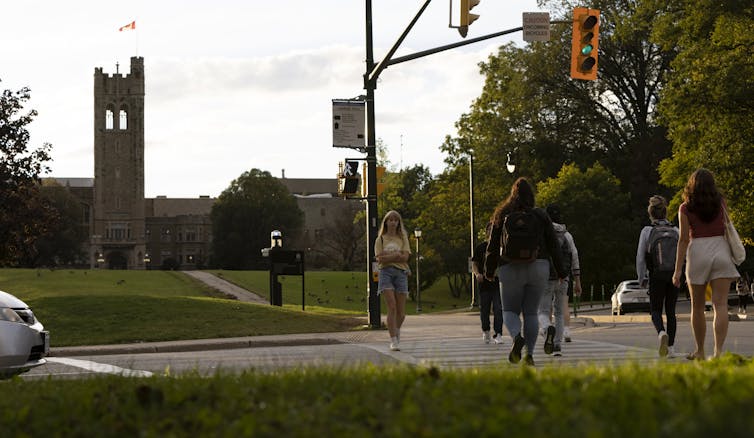News and Updates
Contact
Faculty of Social Science
Social Science Centre
Room 9438
Western University
T. 519-661-2053
F. 519-661-3868
E. social-science@uwo.ca
How accessibility for disabled university students can benefit all students
November 14, 2022
Although many university students are eager for in-person elements of the university experience they missed early in the pandemic, what might we overlook in the rush to “return to normal”?
The pandemic forced universities to re-evaluate their delivery of classes, extending remote teaching practices and building in flexibility to manage an unpredictable situation.
After over two years of innovation, if the main lesson universities take away from the on-going pandemic is that students miss being on campus, we risk squandering new skills and insights of broad value.
In the midst of the pandemic’s long-term effects, including, for some, the disabling effects of Long COVID, we wondered what disabled students could tell us about what makes university classes more (or less) accessible to them. Their insights highlight practices that can benefit a wide range of students.
As the Council of Ontario Universities points out, accessible teaching means designing courses from the get-go with accessibility for a broad range of students in mind, rather than introducing accommodations as needed.
With this approach, instructors can improve student learning, deepen inclusion of students and reduce instructor workload associated with dealing with exceptions and individual accommodations.

Our case study
I worked with a research team of undergraduates, Kate Mahoney, Sam Schneider and Anika Sebudde, to explore how instructors’ everyday practices impact — positively and negatively — students who self-identify as disabled. Anthropologist Andrew Walsh, a colleague at Western University, helped design our research process.
Our survey received 83 responses from students with disabilities from across Western University. We sought not to secure a representative sample, but rather to gain insight into some disabled students’ lived experiences, by means of open-ended questions.
For context, in Western’s 2021-22 Equity Census, almost 10 per cent of student respondents indicated they have a disability. This seems low, given that across Canada, one quarter of university students graduating in 2021 reported having a disability
More disabled students than we think
Our respondents represented every level of student study and faculty on campus. About 75 per cent of our respondents have a diagnosed disability, while the remainder have both diagnosed and undiagnosed disabilities (about 20 per cent) or lack a diagnosis (about five per cent).
This helps explain the finding that about a third of our respondents are not registered with the accessible education office. As one noted, a diagnosis of their disability costs $3,000, while another explained there is a two-and-a-half year waitlist to see a specialist about their condition. There are more disabled students than we think.
One striking survey result is that only two of 83 respondents indicated that their disability is visible, while another 17 have both visible and non-apparent (invisible) disabilities. The remaining 64 have non-apparent disabilities. There are more disabled students than we see.
As one student explained:
“Given how I present myself and manage my disabilities, it often appears as though I do not have any disabilities unless I am experiencing acute symptoms. This can result in a need to explain my disabilities.”
Another added:
“It seems like I have to qualify my struggles more often and justify a need for support to a degree that seems unwarranted.”
Access fatigue
Access fatigue is exhaustion people with disabilities face from constantly having to explain their situation and ask for help. Students reported having to negotiate their access needs repeatedly and to disclose private information (sometimes even to classmates, especially when they were assigned group projects).
How often do our students experience access fatigue? “Always” for 19 per cent of our respondents; another 20 per cent experience it at least once a week. A further 23 per cent experience it once or twice a month, bringing these responses together to over 60 per cent.
In other words, disabled students are paying a kind of “crip tax” — the hidden costs of living with a disability — but in time and energy, not just money. This is likely increased by the non-apparent nature of most disabilities.

Most accessible teaching practices
While our research participants have diverse disabilities and situations, they collectively identified clear winning accessibility practices. Many were precisely those practices whose use was expanded during the pandemic.
These teaching practices included:
-
Flexible assignment deadlines. Students with diverse disabilities reported that they experience unpredictable flare-ups of their symptoms that interfere with their ability to meet rigid deadlines and cause them to be penalized. The pandemic made clear that other students also benefit from some flexibility, including those with a range of family responsibilities due to sick children or siblings, elder care or school closures that disrupted schedules.
-
Delivering courses in a hybrid manner, where it’s possible to choose whether to attend lectures in-person or virtually. Students were grateful when, depending on their symptoms, they could access content otherwise delivered in-person via either recorded or streamed lectures (achieved by acts as simple as instructors pressing record when a PowerPoint presentation started or allowing students to join on Zoom). Our participants also valued being able to review recorded sessions even if they attended in person. Access to these options can reinforce and deepen learning.
-
Lecture slides or outlines posted in advance to facilitate note-taking. This practice helps students keep track of the lecture if they are briefly distracted or when their auditory processing speed doesn’t match the instructor’s pace. It also helps students whose first language is not the teaching language.
-
Captioning of audiovisual materials, whether shown in class or assigned for asynchronous (independent) viewing, helps students who are D/deaf or hard of hearing and those with some learning disabilities. Again it helps non-first language students and any students viewing in conditions where the volume cannot be turned up or where there are noise distractions. Research shows “captioning a video improves comprehension of, attention to and memory for the video.”
More welcoming environments
“The pandemic’s disruption showed how much academia could learn from the disability community,” as disability advocate and philosophy of technology scholar Ashley Shew argued in the journal Nature in May 2020.
Like curb cuts, the ramps that slope downwards on sidewalks and improve life for a wide range of people, we hope insights from students with a range of disabilities will contribute to a more accessible and welcoming environment for all students.
Let’s use the knowledge and skills gained through the pandemic to be better, more equitable and more inclusive.
A. Kim Clark, Professor of Anthropology & Assistant Dean (Equity, Diversity, Inclusion & Decolonization), Faculty of Social Science, Western University
This article is republished from The Conversation under a Creative Commons license. Read the original article.

